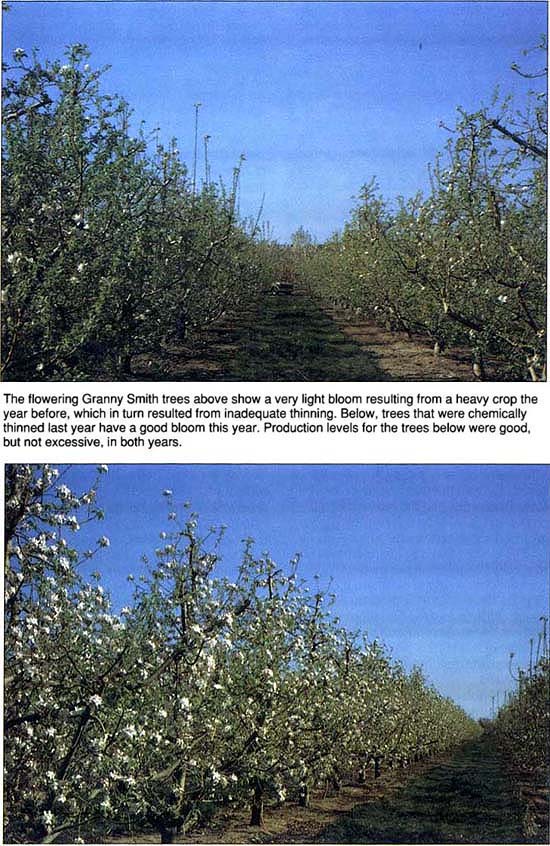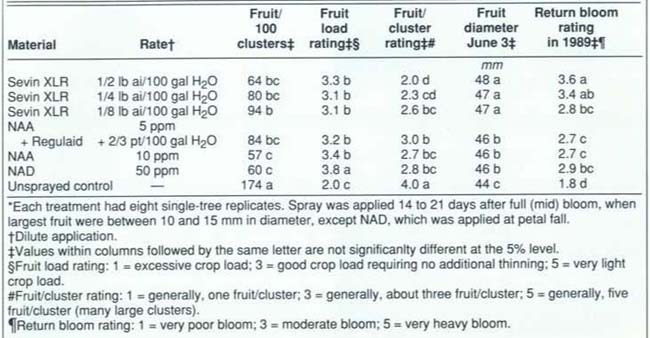All Issues
Thinning Granny Smith apples chemically
Publication Information
California Agriculture 45(1):30-32.
Published January 01, 1991
PDF | Citation | Permissions
Abstract
Chemically thinning Granny Smith apples improved fruit size and, perhaps more importantly, increased return bloom the following year. While carbaryl did the best job of chemical thinning, two other registered materials were also effective.
Full text
The flowering Granny Smith trees above show a very light bloom resulting from a heavy crop the year before, which in turn resulted from inadequate thinning. Below, trees that were chemically thinned last year have a good bloom this year. Production levels for the trees below were good, but not excessive, in both years.
When the Granny Smith apple was introduced into California in the early 1970s, growers believed this variety would require little or no thinning. Reports indicated that chemical thinners would consistently overthin Granny Smith trees. Indeed, the early results from young bearing trees in California showed that the variety required little if any thinning. Older trees, however, do benefit from thinning: it enhances fruit size and may promote a better return bloom.
Recent reports from some southern hemisphere countries also indicate that thinning requirements for Granny Smith vary with tree age and location, and that chemical thinning is becoming more common. The increasing difficulty of obtaining adequate fruit size in California prompted us to initiate these chemical thinning trials.
Chemical thinning has several advantages over hand thinning of apple trees, the most important being the reduction of biennial bearing. Research has shown that the earlier apple trees are thinned, the greater will be the following year's return bloom. Chemical thinning is performed earlier than is generally practical for hand thinning, so it tends to significantly reduce biennial bearing. Chemical thinning also improves the sizing potential of the fruit remaining on the tree, since fewer fruit are present to compete for nutrients and carbohydrates. Chemical thinning is usually less expensive than thinning by hand.
Many factors can modify the effectiveness of chemical thinners. Cool, wet weather at the time of application can prolong drying time and thus increase absorption, making the chemicals more effective. High temperatures after application, particularly if they follow cool periods, can cause mild tree stress and increase the action of some thinning agents, making them more effective. Similarly, anything that weakens the tree or reduces vigor—nutrient deficiencies, water stress, damaged root systems, heavy crops the previous year, or excessive shading within the canopy—can increase the action of chemical thinners. Weak spurs and buds tend to be overthinned. Very vigorous or young trees can be overthinned more easily than trees of moderate or normal vigor. Proper adjustment for these and other factors can prevent inadvertent under- or overthinning.
Preliminary studies from 1985 through 1987 identified 1-Naphthy1 N-methyl-carbamate (carbaryl), 1-Naphthaleneacetic acid (NAA), and 1-Naphthaleneacetamide (NAD) as useful for thinning Granny Smith (unpublished data). In intensive 1988 and 1989 studies with these three materials, we used a handgun sprayer to make dilute applications at rates of 3 to 4 gallons of spray mix per tree. Materials usually were applied in the morning and early afternoon while temperatures were about 70°F. We applied NAD toward the end of petal fall, and carbaryl and NAA when the largest fruit were 10 to 15 mm in diameter, 2 to 3 weeks after mid- (peak-) bloom for these two years.
1988 trial
In 1988, we applied one carbaryl formulation (Sevin XLR) at several rates. NAA was applied at 10 ppm alone or at 5 ppm when combined with a surfactant (Regulaid), and NAD was applied at 50 ppm. All three materials led to significant thinning, compared to the unthinned control (table 1).
A common way to measure thinning is to count the number of fruit that set for each 100 blossom clusters. Each material reduced the fruit set by at least half compared to the control. NAD, NAA at 10 ppm, and carbaryl at 1/2 lb active ingredient (ai) per 100 gallons of water reduced fruit set by two-thirds, leaving a fruit load that would require no additional hand thinning. When three researchers visually rated the amount of thinning on a scale of 1 to 5 (1 excessive crop load; 3 good crop load requiring no additional thinning;5 very lightcrop load), all materials and rates showed good thinning (a rating of just over 3). NAD caused significantly more thinning than the other materials, perhaps lightly overthinning the trees.
The number of fruit in each cluster was also rated 1 to 5 (1 generally, one fruit per cluster; 3 generally, three fruit per cluster; 5 generally, five fruit per cluster, many large clusters). While these ratings gave relatively small differences, they did show that carbaryl generally reduced the number of fruit per cluster better than NAA or NAD. At times, NAA and NAD eliminated all fruit on some clusters and left other clusters essentially unthinned.
Table 1. Results of 1988 chemical thinning trial for Granny Smith apple trees in San Joaquin County*
Table 2. Results of 1989 chemical thinning trials for Granny Smith apple trees in San Joaquin County*
To see how the various treatments affected fruit size, on June 3 we measured the diameter of 20 randomly selected fruit, 10 from each side of the tree. Though differences were not great, the fruit on carbaryl-thinned trees were consistently and significantly larger than on those thinned by NAA or NAD. The unthinned control trees had the smallest fruit.
In spring 1989, we evaluated the effect of 1988 thinning treatments on return bloom by rating the bloom density on a 1 to 5 subjective scale (1 very poor bloom; 3 moderate bloom; 5 very heavy bloom). Each thinning treatment gave a significantly better return bloom than the unthinned control (table 1). In general, trees sprayed with carbaryl had a better return bloom than those treated with NAA.
1989 trial
Three formulations of carbaryl (Sevin 50 WP and two flowable materials, Sevin XLR and Sevin 4F) were evaluated in 1989. We found no significant differences among these formulations in the number of fruit per 100 blossom clusters, fruit load rating, fruit-per-cluster rating, or weight of fruit at harvest (table 2).
We also compared three rates of the Sevin 4F formulation of carbaryl, but found no significant differences among the rates used. NAA with less Regulaid than was applied in 1988 gave reasonable thinning, but generally not as much as with carbaryl. The carbaryl-treated trees tended to have fruit that were slightly larger at harvest than those treated with NAA, though the difference was not significant. As in the earlier trial, the 1990 return bloom from each 1989 chemical thinning application was significantly greater than for the unthinned control trees.
Our results for both years indicate some latitude in the amount of carbaryl needed for acceptable thinning. Still, we must keep in mind that these treatments were applied with a handgun sprayer, and commercial applications applied with airblast equipment may not give as good a coverage as was obtained in our studies.
Discussion and conclusions
Any of the three registered chemical thinners used in this study can thin Granny Smith apples. Carbaryl tended to give somewhat more consistent results, particularly in the number of fruit per cluster and the amount of return bloom. Also, carbaryl treatments appeared to result in larger fruit than NAA or NAD treatments.
Based on these results, we suggest that growers with Granny Smith orchards having heavy bloom try carbaryl at 1/2 pound ai per 100 gallons of water, applied as a dilute spray (300 to 400 gallons of spray mix per acre) when the largest fruit are between 10 and 15 mm in diameter. Growers should try lower rates in orchards having good, but not heavy bloom, while orchards with light bloom may not need treatment. Applying carbaryl can sometimes cause spider mite outbreaks by killing mite predators. While no such outbreaks occurred in our tests, growers should be aware of the possibility.
Chemical thinners tend to overthin the lower parts of trees, where growth can be weaker and somewhat shaded. Also, spray from dilute applications tends to drip through the tree, and accumulate on lower, inner portions of the canopy, contributing to overthinning. The amount of spray mix delivered to lower sections of the tree canopy may need to be reduced by blocking off some lower nozzles or by reducing the orifice sizes at the bottom part of the sprayer manifold.
As noted above, we applied all treatments in the daytime. Spraying at night may prolong drying time and thus increase absorption and thinning.
Once you have chemically thinned your trees, exercise utmost caution in any followup hand thinning. Do not hand thin until after allowing 3 to 4 weeks for chemically thinned fruit to drop; otherwise you are apt to overthin the orchard.
Chemical treatments may result in overthinning, but the advantages of chemical thinning for mature Granny Smith apple trees appear to offset the risk. Because so many weather and orchard factors can affect the success of a chemical thinning program, we encourage growers to gain experience by making applications to limited acreages, and keeping accurate records of the material and rate applied, weather and tree conditions before, during, and after application, and amount of thinning achieved. You should always leave some trees unsprayed as a basis for evaluating thinning obtained on treated trees. As with any chemical application, be sure to read and follow label instructions. Pay particular attention to reducing hazards to honeybees when applying carbaryl; Sevin XLR and 4F formulations are less hazardous to bee brood than are Sevin 50WP and 80S.
California Granny Smith apples are the subject of articles by G. Steven Sibbett et al. ( page 9 ) and Warren C. Micke et al. (page 30) in this issue of California Agriculture.








